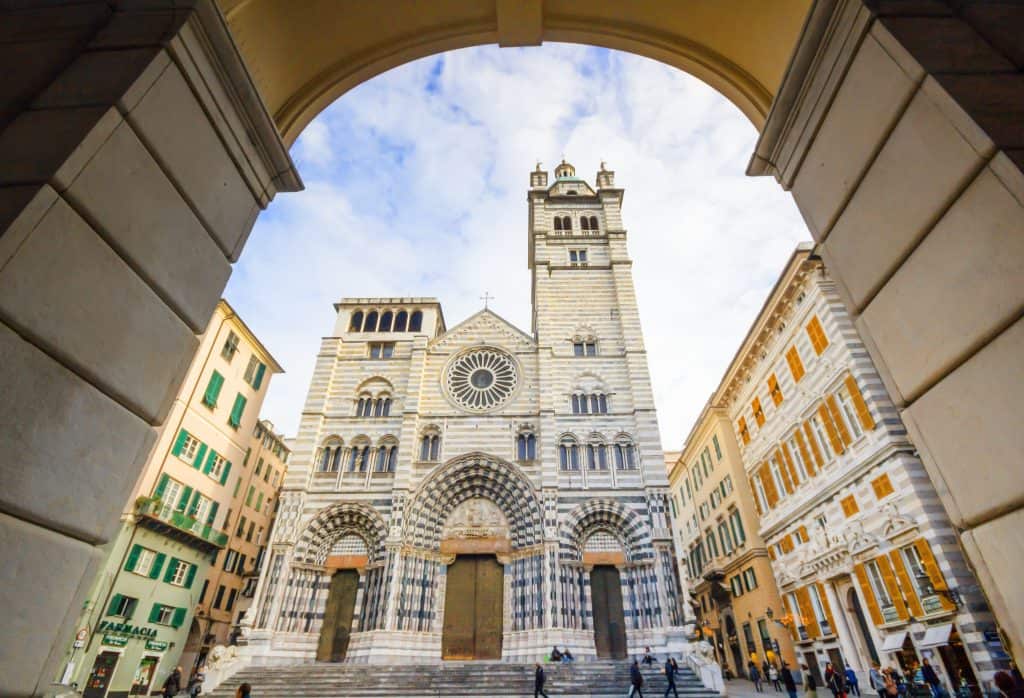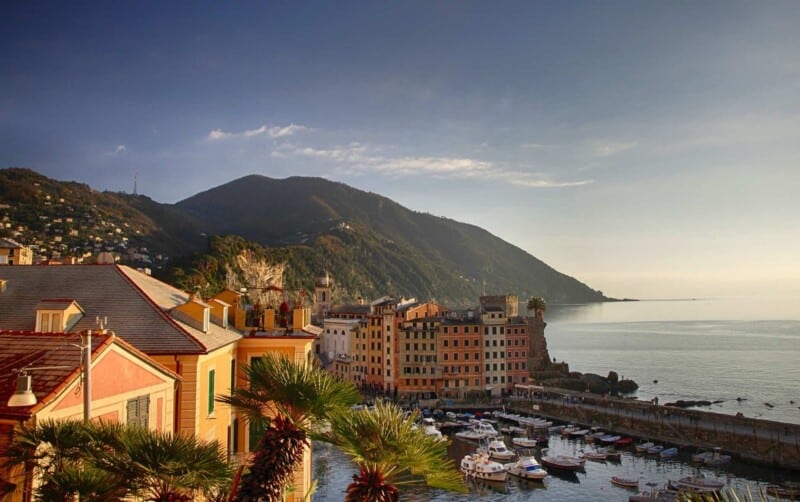Located on the Italian Riviera, Genoa, the capital of the region of Liguria, offers visitors plenty to see and do. With so much incredible architecture and rich history, planning a trip to Genoa and hitting all the best attractions can be tough. To make it as easy as possible, we’ve compiled a list of the best things to do in Genoa, Italy.
Filled with museums, impressive defensive structures dating back thousands of years, royal castles, and more, Genoa has everything you could hope for in an Italian vacation.
So, without further adieu, let’s look at the best things to do in Genoa!
Spend Some Time at Piazza de Ferrari

As with most Italian cities, Genoa includes many public squares and spaces. The main public square and the social center of Genoa is the Piazza de Ferrari. You’ll find its iconic circular fountain at the center of the piazza, with jets of water all around shooting towards the center.
Surrounding the Piazza de Ferrari in all directions, Genoa’s bustling streets await, ready to be explored. Within the square, you can grab a coffee and admire some examples of fine Italian architecture. You’ll see the city’s leading Exchange, Teatro Carlo Felice Opera House, and more.
Visit the Aquarium (Acquario di Genoa)

Acquario di Genoa is a wondrous structure that is considered the premier aquarium in Italy. It’s one of the biggest aquariums in all of Europe in terms of size and number of exhibits, so it’s not something that you’ll just stop in on your way to something else and be able to knock out in an hour or two.
Outside the many fish exhibits and other marine life, there’s also a tropical garden. To fully explore all the exhibits and take in everything that the aquarium has to offer, you’d need to spend days. But in general, plan for at least half a day for the aquarium while in Genoa.
Stop by the Porta Soprana Gatehouse

After sipping your coffee in Piazza de Ferrari, head down Via Dante towards the south, and you’ll come right up to the Porta Soprana Gatehouse. Porta Soprana is part of the city’s original fortifications from the 12th century, and the towers still stand tall, looming overhead from a distance.
The impressive gatehouse will take you back in time, and you can imagine the days when these massive walls and imposing gates were needed to actually keep invaders at bay and protect those within the city walls. Nearby the gate, you’ll also find the house where the famous explorer Christopher Columbus grew up. The house has little to see, but you might as well stop by for a quick look. Porta Soprana Gatehouse is close to several accommodations to book in Genoa.
Check Out the Exhibits at the Maritime Museum

While the aquarium allows you to check out countless examples of marine life, the Genoa Maritime Museum lets visitors dive into maritime history. It’s a great way to spend the other half of your day after exploring the aquarium, and there are options to suit various interests in this museum. You can get entry tickets online in advance to skip the line.
Genoa used to be a significant naval power in the Mediterranean region. Inside the museum, you’ll find four floors of all kinds of exhibits. Pictures of ships, drawings that were used during construction, and all sorts of navigation equipment fill the display cases within.
Go to Piazza Matteotti

Located very close to the more popular Piazza de Ferrari mentioned above, Piazza Matteotti is another square well worth visiting. The famous Doges’ Palace is located within this square, allowing you to admire and explore another structure in Genoa.
You’ll also find yourself looking at the most impressive and opulent church in Genoa, the Cathedral of San Lorenzo — more on that shortly. Other than incredible examples of architecture, you’ll also find all sorts of shops and boutiques to explore—an ideal place for a walking tour. And markets (think somewhat flea markets) on the square allow you to buy and sell goods and work out a deal with any vendors you choose.
Visit the Cathedral of San Lorenzo

After spending some time at the Piazza Matteotti, you can head north and arrive at the Cathedral of San Lorenzo shortly after that. This iconic landmark within Genoa is an amazing example of three different styles of architecture and design — Romanesque, Gothic, and Renaissance.
While the outside of the cathedral is stunning, it gets even more impressive when you step inside. The massive open area, the intricate details along the walls, and the many art pieces are all exciting to see. But don’t forget about the treasure room below. In the treasure room, you can find many examples of religious history, including the ashes of St. John the Baptist.
Explore Forte Begato

Forte Begato is a relatively new defensive structure compared to many others in Italy. Construction was completed in the early 1800s. It is over 200 years old still, but when many structures in Genoa are nearing a thousand years old, it isn’t quite the same! Due to its semi-modern construction, Forte Begato was actually used during WWII to house prisoners of war, adding to its rich history.
Although the fort is closed to the public and you cannot tour the inside, you can hike up to it and appreciate it from outside. Perhaps even more impressive than your views of the fort are the views of the surrounding areas that you’ll get from the top of the hill. The fort’s high vantage point affords visitors unobstructed views of the Genoan countryside.
Go See the Palazzo Reale

To see another impressive piece of Italian architecture and construction, take some time out of your day to visit Genoa’s royal palace, the Palazzo Reale. This imposing structure takes up much of the skyline when you’re looking at it and dominates the city’s skyline with its robust red construction and towering windows.
Construction began on the palace in 1618 under the Balbi family. Over the years, the palazzo was sold and switched hands a few times before eventually becoming the state’s property just over 100 years ago in 1919. The interior of the palace is even more impressive than the outside. Inside, you’ll find art adorning all the walls, draperies dominating others, and lavish decorations throughout.
Visit Castello d’Albertis

Appearing much older than it is, the Albertis Castle (Castello d’Albertis) was built relatively recently, in the late 19th century, to revive Gothic architecture. Even though the castle is new compared to many other places in the city, it’s built upon the foundations of a much older 12th-century castle that has long since been destroyed.
Ascend to the top of the Castello and take in panoramic views of the sea and Genoa, an experience like no other within the city. Inside, the castle also houses the Museum of World Cultures, where you can explore the many displays and exhibits and learn about different cultures from all over the world.
Check Out Lanterna di Genoa at Night

After you’ve been exploring all day and experiencing the bustling streets of Genoa, it’s time to relax and take in one last beautiful sight once the sun goes down. As the sun creeps below the horizon, the ancient lighthouse known as Lanterna di Genoa is lit and shines brightly over the rest of the city below.
As the third oldest lighthouse in the world, it’s an amazing feat of engineering and construction that still stands to this day and looks so ornate even by today’s standards. You can see Lanterna di Genoa from many places in the city or while on a segway tour, so it’s a great time to grab some gelato or other dessert at one of the city’s many cafes and look up at the lighthouse against the backdrop of the Italian night sky.
Related Resources


0 Comment